WARGAMESOSD The Struggle for Poland |
 Axis forces (green, grey air force counters): Polish (red counters); Lithuania (yellow counters); and Soviet forces (brown counters) - Byelorussian Front seen here top right |
Sample
of Play - Optional Rules Used |
| Poland - key defensive areas |
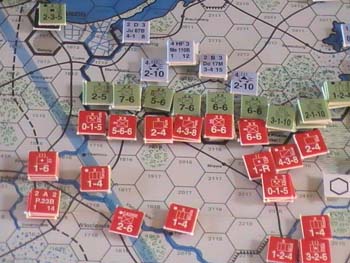 The North - Army Modlin faces the German 3rd Army and must protect Warsaw from the north - defences fortified | 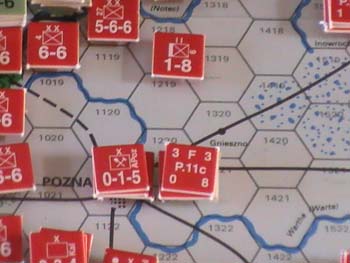 Army Poznan will protect Warsaw to the west, if and when it falls, a defensive line in depth will be drawn at Lodz |
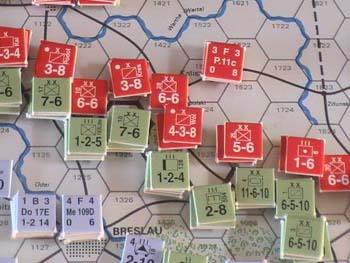 Helping Army Poznan, Polish forces to the south of the city defend the more southerly gateway to Lodz & Warsaw | 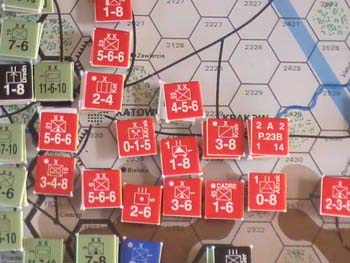 The strategic defence of Katowice and Krakow will help prevent the Axis forces from attacking Warsaw from the south |
| The Attack Begins - Katowice Falls |
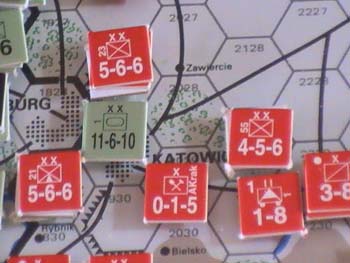 Turn 1: 1 September 1939 - Katowice falls when it is attacked by the 11-6-10 1st Panzer Division, areas around it are fortified but it is not enough to prevent the Axis advance | 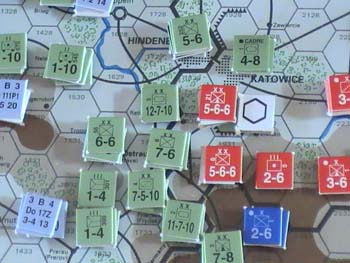 Turn 2: 4 September 1939 - Army Group South (14th Army) consolidates its position and hold on the city, Axis reserves (the 6-6's) move forward to support strong panzer divisions |
Turn
1 & Turn 2 - 1 September - 6 September 1939 Turn
2 Army Group South -
Reserve divisions of Army Group South move to the front line (8 infantry divisions,
2 mountain divisions and artillary). Germany received 4 x He111P1 Bombers (2B3)
as reinforcemnets. Assault on fortresses south of Katowice with partial success,
and foothold by SS infantry regiment on western edge of Carpathians. Two mountain
divisions are rebuffed, however, in the Carpathians by Polish defenders and have
to retreat 1 hex. |
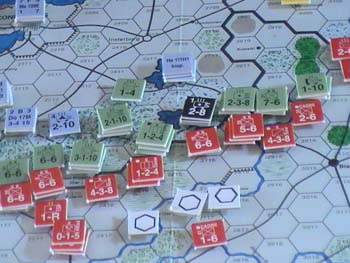 The defence of Northern Poland - Army Modlin manages to survive the initial attacks from Army Group North's 3rd Army Group attacking from East Prussia | 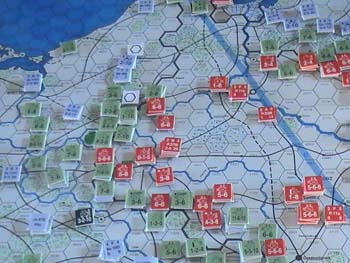 The gap in the Polish defences in the north west (top centre of picture), note also the break-up of defences in the west and in the south - the Polish defenders regroup |
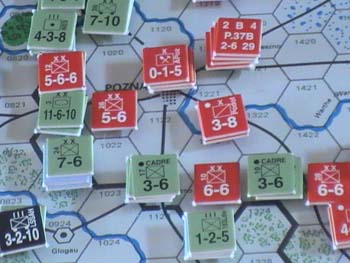 Army Poznan struggles to defend the western borders and to the south of the city Axis forces begin to break through, though with heavy losses - note units flipped to their cadres | 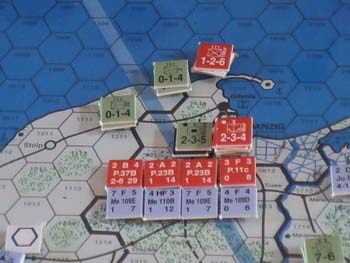 Poland fights back - the offensive at Danzig, Poland fields more than half its air force squadrons in support of the attack. Note axis unit is Police unit and underneath is a 0-1-4 static SS unit |
| Turn
3 - 7 September - 9 September 1939 Army Group North is beginning to frustrate the Polish Army and there have been some losses. Howver, two Polish divisions counter attack and achieve some success. Army Group South consolidates its hold on Katowice and now threatens Krakow with 3 divisions and 3 battalions, assault engineers and an assault artillary battery. The Poles have 3 infantry divisions and another in reserve, as well as the Krakow Cavalry division. The Polish Army has some success in the central west where Army Poznan successfully defends the city against a spearhead attack by several divisions from Army Group North. Krakow to the south west is well defended but could fall in the next two turns. German Army expected to reinforce from the Westwall Holding Boxin next turn, especially if France does not intervene on Turn 4 |
| The Defence of Warsaw |
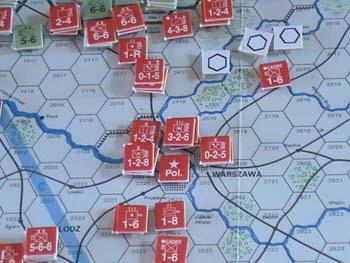 Artillary, a tank battalion and infantry units lie to the south of Warsaw. Lodz is well garrisoned to the south-west and in the north Army Modlin moves to protect the capital | 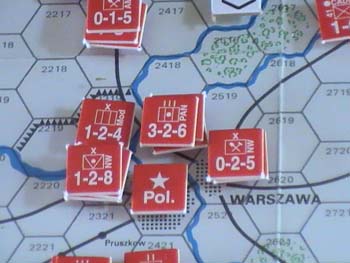 Warsaw is fortified and has seige artillary as well as anti-tank capabilities. The capital must resist evacuation which will trigger a Soviet invasion of Eastern Poland |
| Turn
4 - 10 September - 12 September 1939 No French intervention. Germany transfers 16 divisions and 2 artillary regiments from the Westwall to the East (at a cost of 114 pts, the Westwall is reduced from strength 271 to 157) Lithuania enters the war on the Axis side (Die roll 1), reinforcements due on Turn 3 are entered into the order of battle, Lithuanian sphere of operations may only extend up to 3 hexes outside Lithuania (Rule 31F). Lithuania invades north-eastern Poland. Krakow falls at the end of Army Group South offensive. c/m Units consolidate hold on Krakow in the Exploitation Phase, with the over-run of a Polish cadre unit retreating from Krakow. |
| Turn 4 - Lithuania Enters The War |
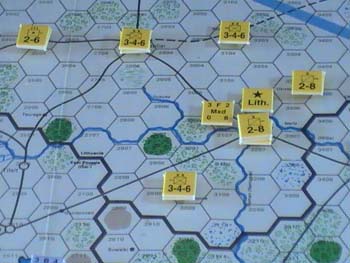 Turn 4 - The Lithuanian Order of Battle, as at set-up. Lithuania has a number of infantry divisions, an artillary division and a fighter squadron based in the capital Kaunas | 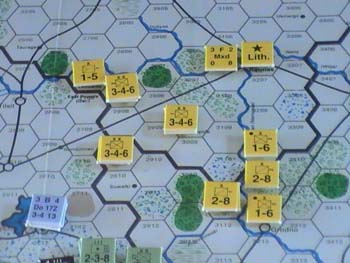 Turn 4 - Lithuanian forces invade north eastern Poland, but with little or no strategic gain as this stage - she can only progress a maximum of 3 hexes in support of Axis troops |
| Turn 4 - Krakow Falls |
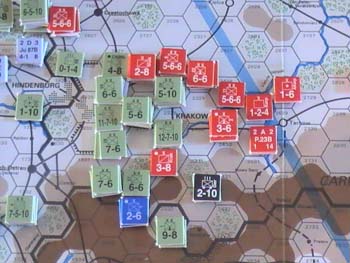 The attack on Krakow by heavy panzer divisions and infantry opens the way north for the German 10th and 14th Armies | 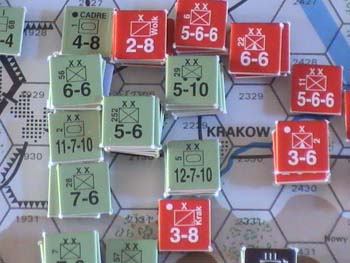 Polish forces, although strong, are pushed north after a heroic defence of one of Poland's key cities. The Axis forces also have c/m (combat/motorized) divisions (5-10's) to secure. |
| Turn 5 - Polish Forces Retreat North - Protective 'Shield Lodz' |
Turn
5 - 13 September - 15 September 1939 8
divisions (xx) from pull back 5 hexes to form defensive
positions in the west. |
| Turn 5 - The Polish Forces Regroup |
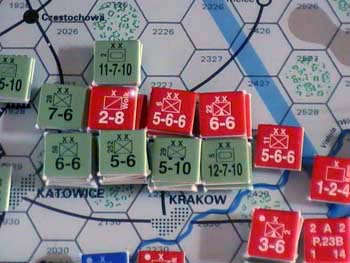 Army Group South makes the Polish defenders feel very unwelcome in the area north of Krakow. The Poles decide on a strategic withdrawal - 5 hexes to the north | 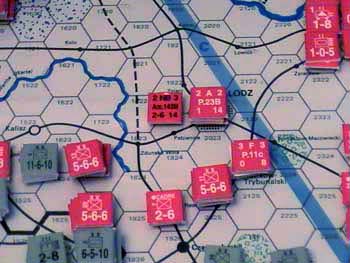 Polish forces from Army Krakow retreat north to join the defence of Lodz 'Shield Lodz'. Note the aircraft based at Lodz that includes the French night-bomber (black text on red) |
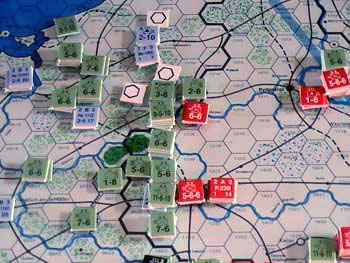 Army Poznan is in an impossible position with huge forces bearing down on the city. With such impossible odds this army group decides to retreat 5 hexes east towards Lodz | 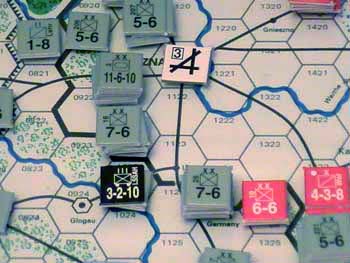 After the retreat, Poznan is abandoned and left for the Axis forces on their blitzkrieg east. Poland fought well in this area but reinforcements from the Westwall were too strong |
| Turn 6 - Westwall Weakens as Lodz Prepares |
| Turn
6 - 16 September - 18 September 1939 French attack on Westwall, strength now down to 13 points, transfers will be required from the east to support the Westwall. Westwall strength brought up to 50 points bvy transfers from the east - 12 divsions and 2 artillary. Army Group North and Army Group South gears up for what it believes will be the final offensive in Poland, as the Westwall is too weak and may fall in next turn. Army Group North and west suffers a number of retreats and stand-offs. Army Group South has more success - one significant retreat though with a 12-7-10 Armour Division humiliated. Attacks with 2 Stuka squadrons (JU87B's) on Polish mountain units in a 6:1 ratio combat - defender halved (Die roll = 3) Four divisions of Army Group South have broken through north of Czestochiowa and will now threaten Lodz. |
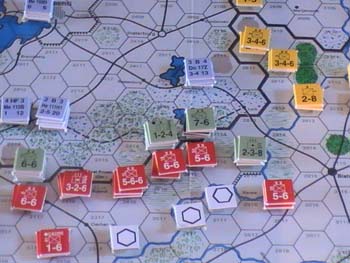 Army Group North has suffered constantly from bad die-rolls and has struggled to break through the fortified Polish held lines | 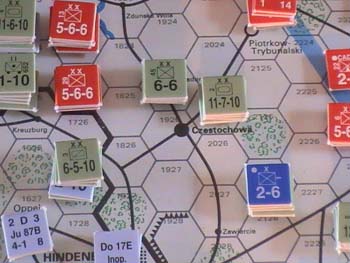 Army Group South prepares its attack on Lodz, the last strong- hold before Warsaw. If Lodz is captured this will immediately trigger the evacuation of the Polish Government |
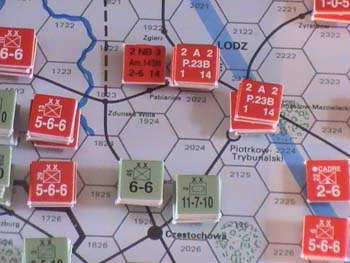 Lodz, before Poland prepares its defence, troops are retreating from the west and will fill the gap to the south of the city, ready for the attack | 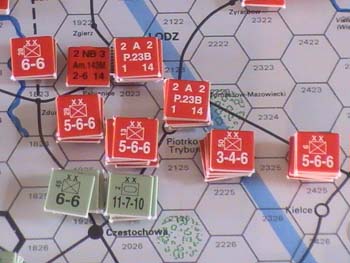 Polish defenders in place, ready to resist the attack. Note strong panzer (11-7-10) divisions which will pound the defenders, but also note Polish Air Force squadrons and French night-bomber |
| Turn 7 - A Polish Decisive Victory |
| Turn
7 - 19 September - 21 September 1939 The French attack the Westwall and roll a '3', with only 50 points needed to end the game - the Westwall is reduced to zero and therefore the game ends in a decisive victory for Poland. |
| Endgame - The Luftwaffe Blitzkrieg Offensive |
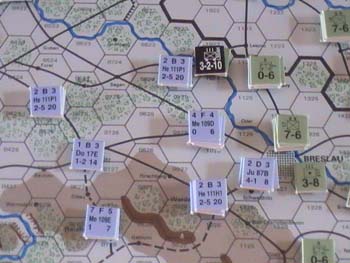 The Luftwaffe in the west, note fighters (7F5's, 4F4's), bombers (2B3's) and dive bombers (2D3's), it was not enough to prevent a German catastrophe | 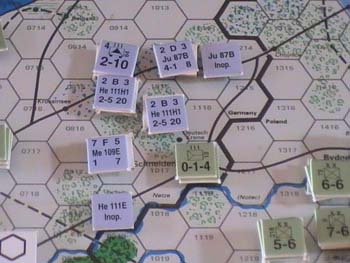 The Luftwaffe in the north did not contest Danzig after it was exclusively occupied by the Poles, however, more Blitzkrieg tactics could have been employed elsewhere in hindsight |
The
End of a Nightmare |